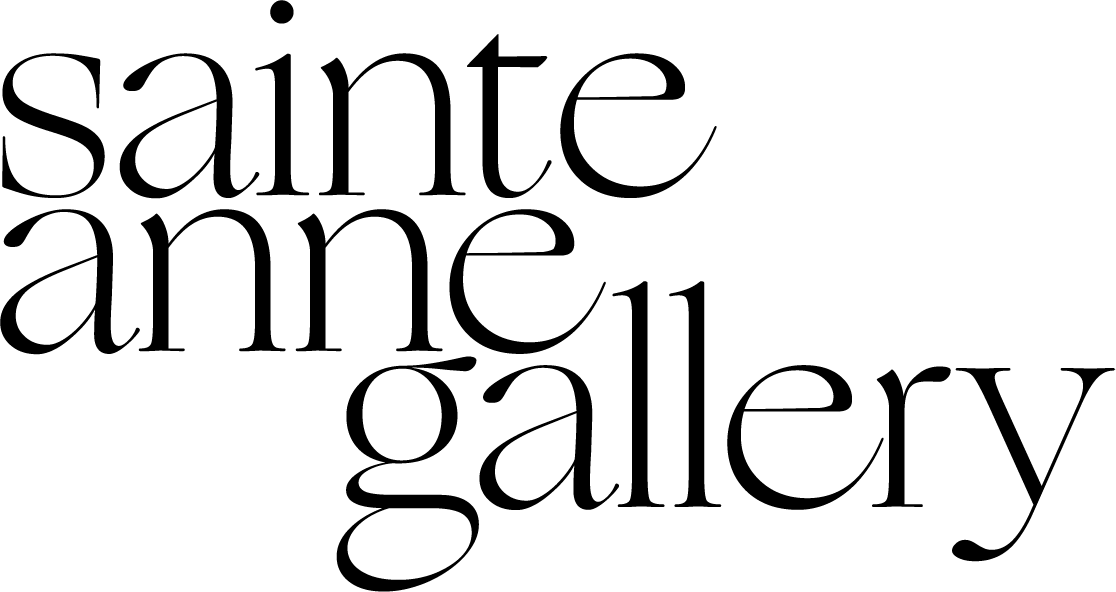


A Shadow's Shadow
by Alizée Gazeau
7 — 30 March 2025
With the support of CNAP Centre national des arts plastiques
(National Centre for Visual Arts), France
Alizée Gazeau (b. Paris, 1990) lives and works in Berlin. She holds a master's degree in art history from La Sorbonne, where she also studied philosophy of art.
Solo exhibitions include I’m Herdsman of a Flock, Stallmann Galleries, Berlin, Germany (2024), Häutung, Gr_und with the support of the French Institute, Berlin, Germany (2023), Le Filet, Ona Project Room, Tokyo, Japan (2022), Heureux qui comme Ulysse, Bubenberg, Paris (2017).
Recent group exhibitions include Mass, Spoiler Zone, Berlin, Germany (2024), H20 Venezia: Diari d’Acqua, Fondazione Barovier&Toso, Venice, Italy (2024), Archive of Upcoming, Georg-Knorr Bremse Factory, Berlin, Germany (2023), Art Theorema Krisis, Fondazione Benetton, Trevise, Italy (2023), Off Water II, Sainte Anne Gallery, Paris, France, (2022), Interfaces, or those who caress the surface, Interface, Berlin, Germany (2021), But are we the only dreamed ones?, Daily Lazy Project, Athens, Greece (2019).
Alizée Gazeau was resident at the Cité Internationale des Arts, Paris, France (2019-2020, 2025), at the Fondation Hartung Bergman, Antibes, France (2018), at the Fondazione Michelangelo Pistoletto, Biella, Italy (2018).
She founded Publication d'Art Non linéaire, a collective publication of artists and historians, giving rise to several events and conferences, at Musée Pierre Soulages, Rodez, France, at Cité Internationale des Arts, Paris, France, at Emerige Voltaire, Paris, France (2018-2022).
_________
A Shadow’s Shadow
a conversation between Alizée Gazeau and Joséphine Dupuy-Chavanat
Joséphine Dupuy-Chavanat: “ To title is to write a little!” said Alechinsky in 1911. Your first solo show was entitled Heureux qui comme Ulysse [Happy who like Ulysses], evoking the journey and the fragmentation of memory, while your second, Häutung [Molting], explored the idea of metamorphosis and the creative process. Recently, your much more conceptual exhibition I'm Herdsman of a Flock looked at the transformation, permeability and polysemy of familiar objects, particularly those from the marine and equestrian worlds.
What motivated the title of this new exhibition at Sainte Anne Gallery?
Alizée Gazeau: A Shadow's Shadow is a quote from Hamlet. The exhibition is the first personal presentation of my paintings and sculptures in Paris after four years living in Berlin. I wanted to compose a series of paintings based on past and recent sensations, like the cast shadows of memory.
Shadows come with light. The shadow of a shadow is two lights on objects that project onto each other. I like the idea of repetition, of the same word, the same motif, like a rhythm, a poem, a dance. A little further on, Shakespeare writes 'a dream itself is but a shadow'. In the paintings, we recognize the object of the net, the hammock, but as in a dream, it is no longer exactly the object, nor its abstraction.
Three ensembles of sculptures punctuate the exhibition. They follow on from the horse saddle sculptures exhibited in November at Stallmann Galleries in Berlin.
Joséphine Dupuy-Chavanat: So there's a fluidity, a kind of interstice that you constantly capture in your work. A moment that also seems suspended, between two states. The net, for example, seems to escape us the moment it appears. As for the leather straps, they play on the varying degrees of tension in their braiding, fused at one end and loose at the other. You mentioned recent sensations. Can you tell us what they are and how they may have influenced the paintings and sculptures presented here?
Alizée Gazeau: You said that the exhibition of horse saddle sculptures was more conceptual than previous ones. This is true and paradoxical at the same time, because it marks a moment when I have fully assumed the part of sensitive intuition in my work. The horse saddles, the braids made from their girths, the pieces cut from leather are sensual elaborations that respond to a very direct intuition.
The net is an object I began collecting in 2019. Instability, loss and the fluctuating memory of a place are translated into painting through this object. Working on the ground, with pigments and water, it becomes a tool that allows me both to hold the paint on the surface of the canvas and to let it escape. There's a tension between letting go and holding back that I like to find in the process. As you say, we find the same tension between the idea of capture and liberation in the leather braids. These archetypal objects are like metaphors.
Joséphine Dupuy Chavanat: And what are these metaphors?
Alizée Gazeau: The idea of metaphor is that of a displacement from the original object.
“Hammocks and fishing nets stem from ancestral practices. The oldest known fishing net in Europe dates from 8300 BC. The net in ancient Egyptian bas-reliefs functioned as a representational screen and can be seen as a metaphor for space and time.” In my paintings, the nets create spaces and capture events.
The horse saddles are metaphors for the search for harmony between two beings, having an asymmetrical relationship. The sculpture Untitled (stirrups) is made of leather straps and stirrups. The stirrups, designed to maintain balance, are aligned vertically on the straps. They evoke a ladder, the axis mundi, that is, the connection between Heaven and Earth.
When I speak of metaphor, I am referring to the idea that the work eludes definition, constantly projecting its form onto an infinite number of other thoughts.
Joséphine Dupuy Chavanat: I remember you sharing your thoughts with me when I was working on a project involving the graphic interpretation of music. You told me that between the appearance of a form and its disappearance, there exists a fragile compositional equilibrium. And painting - like music - seeks harmony. How does this quest for harmony, a subject that has long been dear to you, continue to infuse your work? I say “quest”, but perhaps you have found the right melody, the right rhythmic flow and the perfect consonance?
Alizée Gazeau: Yes, the word harmony was a recurrent theme. Music provokes instant emotions. I would like my paintings to be listened to and my sculptures to be perceived as a rhythm. This may sound abstract, but at the same time it is concrete in my works. Shapes appear as much as they vanish. I like them to produce a temporal, musical impression, something both anchored and fleeting. In the First Dance and Movement paintings, I searched for a perfect balance between light and darkness, a point of equilibrium between two opposites.
“The ocean is deathless
The island rise and die
Quietly come, quietly go
A silent swaying breath”
Agnes Martin
I'm also thinking of Roni Horn, Sigmar Polke and Eva Hesse.
Joséphine Dupuy Chavanat: I do indeed remember the Sigmar Polke exhibition at Palazzo Grassi in Venice, which described the artist as “the painter of metaphors”. One of the huge works on show featured circus characters and animals balanced on chairs, buckets and ladders. Polke transforms and even metamorphoses his colors, like an alchemist. How do you work with materials and colors? Do you, like Polke, seek to create - through a singular use of pigments - a state akin to hypnosis?
Alizée Gazeau: I began imagining the paintings for the exhibition during a few weeks spent away from my studio. As always in my work process, I need to immerse myself in places, readings, conversations and emotions to prepare a new series. Back in the studio, a blending occurs between my intentions and the interactions that take place between pigments, paint, water, threads and the surface of the canvas. The paintings from the Surface series are made with a single color. I compose the painting by placing water-soaked nets on the canvas. By moving the pigments, the nets modify the pictorial surface, and after they are removed once dry the final painting appears. In this, I am also a kind of alchemist. There are certain colors that come up frequently: the contrast of black and white that structures the nets, the crimson color of bodily flows, of the sea in the Odyssey, of vital momentum. In the painting Suite, the fleeting shape of the net was almost enough on its own. I wanted to add a blue line to indicate temporality and movement. There is also the imprint of a net that traces a very low horizon line. You speak of a state close to hypnosis. What is certain is that I am led by my intuition, by the fluctuations of my memory and by the beauty of the absolute present offered by a painting in the making.
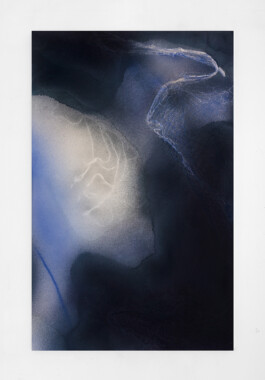
Movement (2025) by Alizée Gazeau; acrylic, ink on canvas, 190 x 120 cm
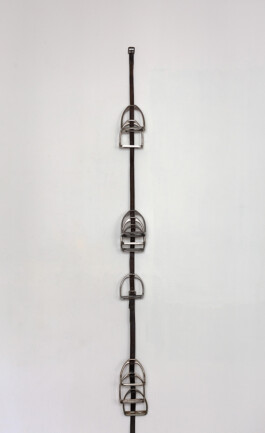
Untitled (étriers) detail 1 (2025) by Alizée Gazeau; leather, stirrups; variable dimensions
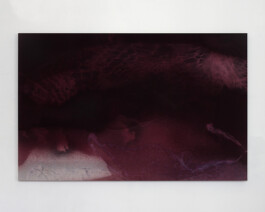
Salt Storm (2025) by Alizée Gazeau; acrylic, ink on canvas, 120 x 90 cm
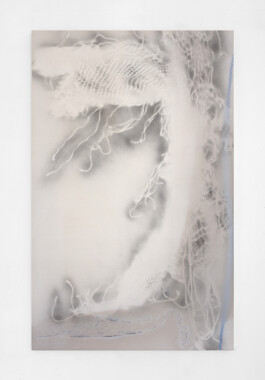
Suite (2025) by Alizée Gazeau; acrylic on canvas, 190 x 120 cm
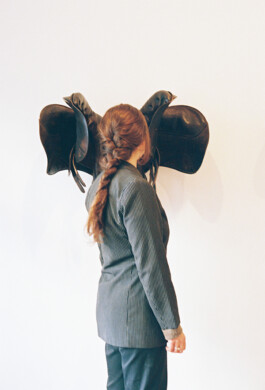
Portrait of Alizée Gazeau by Masha Demianova